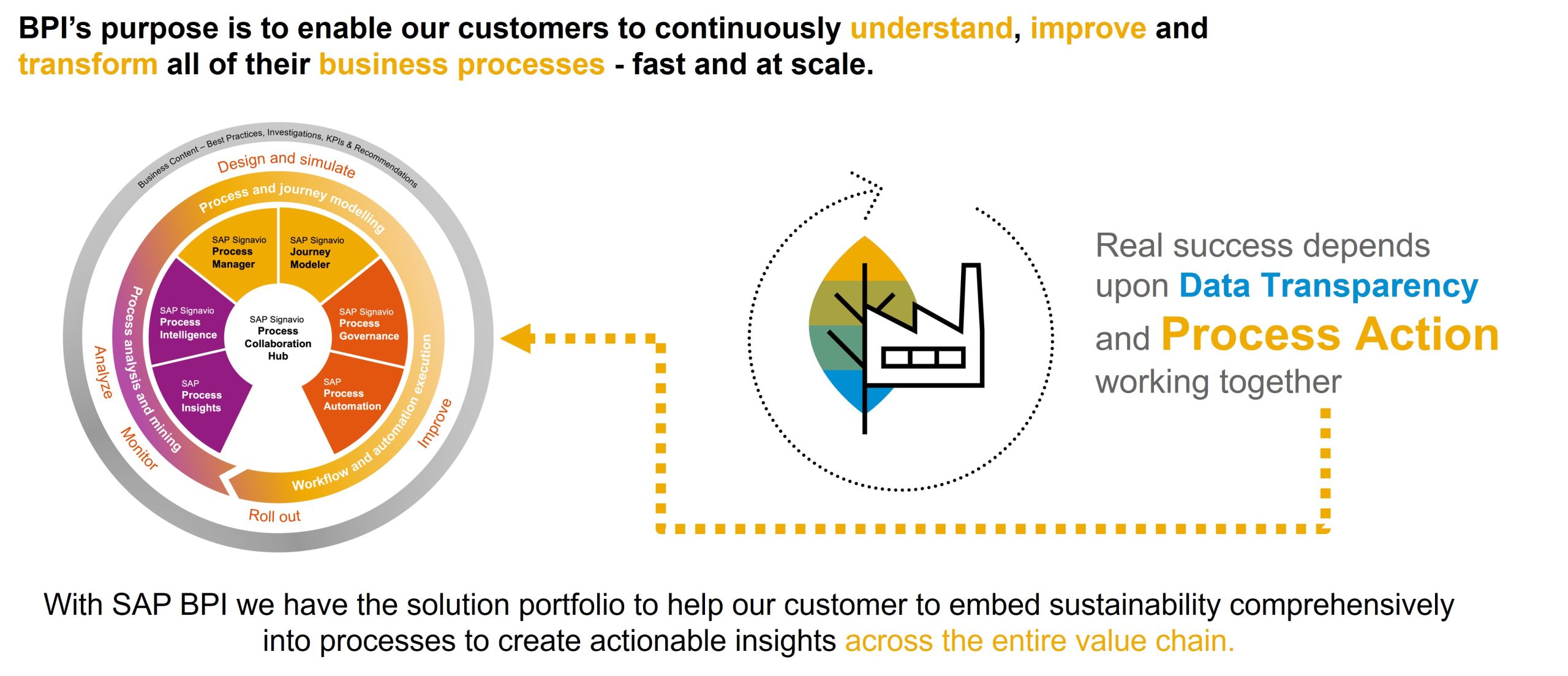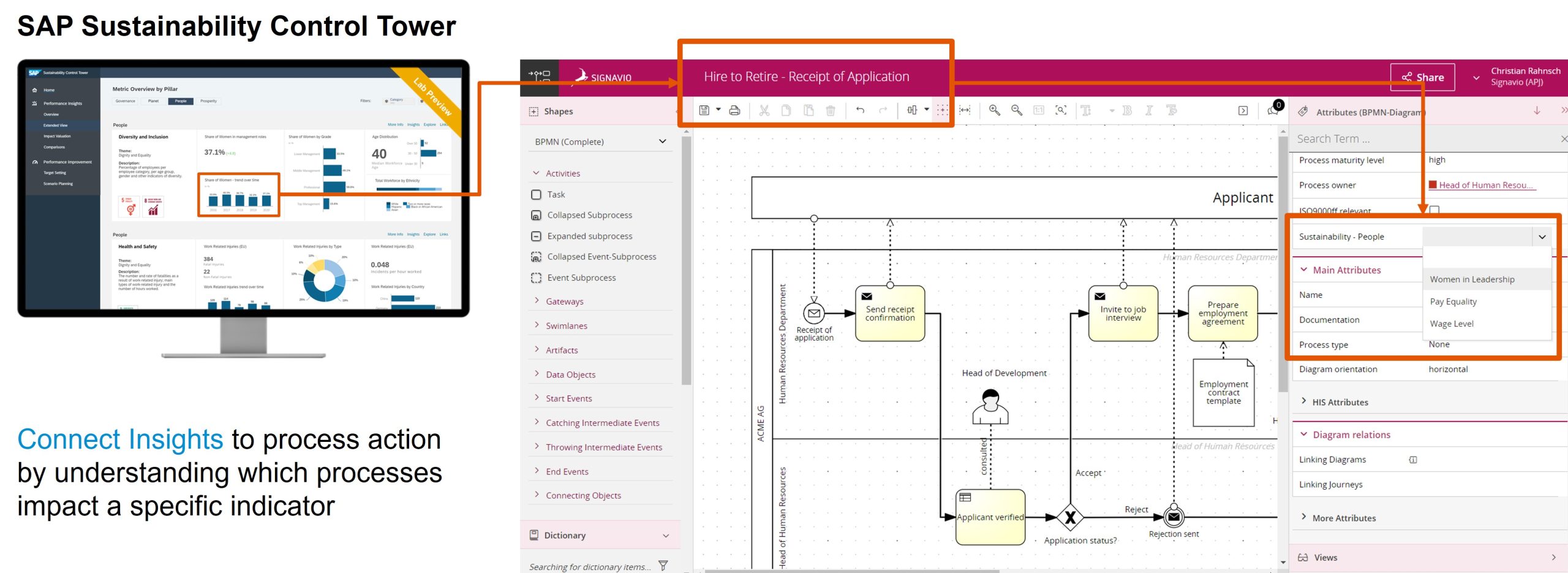Introduction
Sustainability has replaced Digital Transformation as the new hot topic in conferences and board meetings alike around the globe. Investors, regulators, and consumers demand fairly made products and services with smaller planetary impact. For organizations to maintain access to capital, talent, and consumers, they must place sustainability front and center. The challenge for organizations is to make sustainability profitable and profitability sustainable, meaning managing the triple bottom line of profits, planet, and people.
To achieve this, organizations need to embed sustainability comprehensively into processes to create actionable insights across the entire value chain. There is a need for:
- New data structure, which cover sustainability parameters
- New evaluation possibilities, to create insights
- Connect of insights to process action
For organizations, real success depends upon data transparency and process action working together. And process action is managed by Business Process Management. With SAP Signavio Process Transformation Suite, we have the solution portfolio to help our customer to embed sustainability comprehensively into processes to create actionable insights across the entire value chain.

Business Process Management for Sustainability
The Role of Business Process Management
Let’s take a real-life example. It’s a straightforward use case with little complexity to help illustrating the approach. The approach however is applicable for any type of use case where we want to drive process action based on data-driven insights.
Imagine your organization is looking to improve on specific aspects of its people pillar. You used the World Economic Forum sustainability metrics as your framework to define key metrics and managed to gather the required data to create insights. You might have done so using SAP Sustainability Control Tower. One of your metrics shows red! It’s the Woman in Leadership metric. From your evaluation you see that this metric is red in three out of your five business units. You also found out that for these three business units its red in the same four locations. With these insights established you now want to start to take action. And this is where Business Process Management comes in.
In a first step you check which of your business processes have an impact on the metric of “Woman in Leadership”. Luckily for you, your HR process owner and his team have already mapped this information into your business process management tool (e.g. SAP Signavio Process Manager). Specific new attributes made your business processes to be sustainability aware. These new attributes are leveraging the same data structure used to generate the insights in your Sustainability Control Tower.
A quick scan on this metric shows you that there are three business processes that have a direct impact on this metric. Your task force, with representation from the three business units, review the process and the factors that influence this metric. Here they leverage the collaboration capabilities of their BPM tool (e.g. SAP Signavio Process Collaboration Hub). The team quickly discovers that the new ‘flex working policy’ has not yet been rolled out in the four locations that popped up with a red flag.

Process Action for Women in Leadership Metric
The team is confident that based on these insights they have a transparent data basis, and there is no need for a detailed process mining exercise yet. However, they are keeping this option open in case the ongoing monitoring of this metric does not show any improvement. They also decide that they do not need to do a process simulation at this point, as the identified correlations seem to be very straight forward.
The tasks force works with the required teams to roll out the “flex working policy” in the four locations. To ensure process conformance, the team decides to add a new workflow into the impacted processes to assist its employees in following the rights steps (e.g. via SAP Process Automation).
The team monitors how the sustainability metric has improved and is happy to see that the flags now show all green and the organization is experiencing the positive impact of more women in their leadership.
This was just one example where Business Process Intelligence can help an organization to put data insights into process action. In general, we see three typical use cases in an organization’s sustainability journey:
- Meet global compliance and regulations
- Take specific actions such as de-carbonize, reduce waste, or drive social responsibility
- Create new sustainable products, services, and business models
Meeting global compliance and regulations is a use case that has been prominent within Business Process Management for many decades. It’s about identifying risks in your processes and defining and implementing adequate controls. We will explore how SAP Signavio Process Transformation Suite can support this in one of my next blog posts. We will do this based on the new Enhanced Producer Responsibility Policies that are implemented around the globe now.
Taking specific actions such as reducing waste follows the same approach as described in our example. It’s about extending your business processes with sustainability relevant information and being able to optimize them based on sustainability relevant indicators. Here we will see more capabilities in the near future to e.g. incorporate newly established taxonomies such as the EU taxonomy into BPI tools. In one of my next blog posts, we will explore how the SAP Signavio Process Transformation Suite can be leveraged in a more complex use case with a lot of different data points.
Creating new sustainable business models is the most daunting tasks for organizations, as it could mean a huge transformation of the entire business, and as such of most its business processes. In my next blog post we will explore how we can leverage SAP Signavio Journey Modeler to envision new business models, based on the perspective of a customers sustainability journey.
Conclusion
For organizations to be successful in their sustainability journey, they must be able to embed process actions fast based on data-driven insights. Business Process Management has the capabilities to support this throughout the entire lifecycle of continuously transforming business processes.
Stay tuned for my next blog post where we will discover how we can use SAP Signavio Journey Modeler to envision new sustainable business models based on a customer’s viewpoint.
If you are interested to know more about the topic of sustainability you can visit our community page here: https://community.sap.com/topics/sustainability
You can also ask questions about the topic in SAP Community with using this Q&A tag link for Sustainability: https://answers.sap.com/questions/ask.html?primaryTagId=140502597117949649788634441139048

